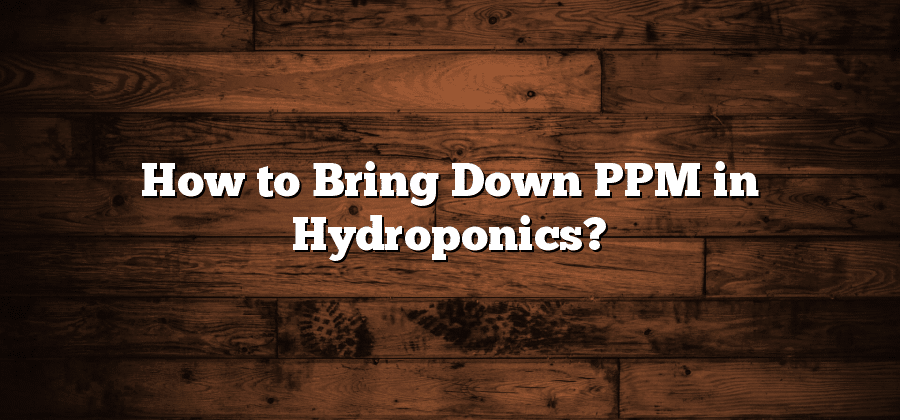Understanding PPM in Hydroponics: An Overview
PPM, or parts per million, is a unit of measurement widely used in hydroponics to quantify the concentration of different substances in water. It is a key parameter that helps growers monitor the nutrient levels in their hydroponic systems. Understanding PPM is essential for maintaining a healthy and thriving hydroponic garden.
In hydroponics, all the nutrients needed for plant growth are dissolved in water and delivered directly to the roots. PPM provides a precise method to measure the concentration of essential elements such as nitrogen, phosphorus, and potassium, as well as trace minerals like magnesium and iron. By monitoring PPM levels regularly, growers can ensure that plants receive the optimal amount of nutrients, preventing deficiencies or toxicities that could hinder their growth. Moreover, analyzing PPM levels can help identify potential problems in the system, such as imbalances or buildup of salts, allowing growers to take corrective measures promptly.
Importance of Monitoring PPM Levels in Hydroponics
Monitoring PPM (parts per million) levels is crucial in hydroponics for several reasons. Firstly, it allows growers to ensure that their plants are receiving the right balance of nutrients for optimal growth. By regularly monitoring PPM levels, growers can identify any imbalances or deficiencies in the nutrient solution, allowing them to take corrective measures before it negatively affects plant health.
Moreover, monitoring PPM levels also helps in preventing nutrient toxicity. When the concentration of nutrients in the solution exceeds the plants’ tolerance levels, it can lead to nutrient burn and other detrimental effects. By regularly testing PPM levels, growers can detect any spikes in nutrient concentration and adjust the solution accordingly to prevent damage to the plants. This proactive approach to monitoring PPM levels can save growers time, money, and the disappointment of poor crop yields.
In conclusion, monitoring PPM levels in hydroponics is of utmost importance as it ensures the plants are receiving the right nutrients in the correct proportions. Additionally, it helps prevent nutrient toxicity, safeguarding the plants from damage. By diligently monitoring PPM levels, growers can maintain optimal plant health and maximize their yields in hydroponics.
Identifying Factors Affecting PPM in Hydroponics Systems
Factors affecting PPM levels in hydroponics systems are multifaceted and can greatly impact the overall success of the crops being grown. One key factor is the type and quality of nutrients being used. Different plants have varying nutrient requirements, and it is crucial to choose the appropriate nutrient solution for each crop. Additionally, the concentration of the nutrient solution directly affects the PPM levels in the hydroponics system. If the concentration is too high, plants may experience nutrient burn or toxicity, leading to stunted growth or even death. On the other hand, if the concentration is too low, plants may not receive adequate nutrition, resulting in nutrient deficiencies and poor yields.
Another factor to consider is the water source and its quality. The PPM levels in the water can vary depending on its source, such as tap water or well water. High PPM levels in the water could lead to an increase in overall PPM levels in the hydroponics system. It is crucial to test the water regularly to monitor its quality and adjust nutrient solutions accordingly. Furthermore, the pH levels of the water can affect the availability of nutrients, which in turn impacts the PPM levels. Proper pH management is essential to ensure that nutrients are readily available to the plants, optimizing their growth and minimizing PPM fluctuations in the hydroponics system.
Overall, understanding and identifying these various factors affecting PPM levels in hydroponics systems is crucial for maintaining optimal plant health and maximizing crop yields. By carefully selecting nutrient solutions based on plant requirements, regularly testing water quality, and managing pH levels, hydroponic growers can effectively control and adjust PPM levels, ensuring the success of their crops.
Adjusting Nutrient Solutions to Lower PPM in Hydroponics
To effectively manage the PPM levels in hydroponics systems, adjusting nutrient solutions is a vital step. Nutrient solutions, which provide the necessary elements for plant growth, can have a significant impact on the PPM levels in the system. By adjusting these solutions, growers can manipulate the concentration of nutrients and ultimately lower the PPM.
One way to lower PPM is to dilute the nutrient solution with water. This method involves adding more water to the solution to decrease the concentration of nutrients. However, it is crucial to maintain a balance between providing enough nutrients for the plants and diluting the solution sufficiently to lower the PPM. This can be achieved by gradually adding water to the solution and monitoring the PPM levels closely. It is important to note that different plants have varying nutrient requirements, so the dilution process should be tailored accordingly for each crop.
Managing Water Quality for Decreasing PPM in Hydroponics
The quality of water used in hydroponics plays a crucial role in maintaining optimal PPM levels. High levels of dissolved solids in water can result in elevated PPM readings, which can hinder plant growth and productivity. Therefore, managing water quality is essential for decreasing PPM in hydroponics.
One effective way to manage water quality is through the use of reverse osmosis (RO) filtration systems. These systems work by removing impurities, including dissolved solids, from the water. By investing in a high-quality RO filtration system, hydroponic growers can ensure that the water used in their systems is free from excess minerals and contaminants, leading to lower PPM levels.
Another important aspect of managing water quality is to regularly test and monitor the PPM levels. This can be done using a PPM meter, which measures the concentration of dissolved solids in the water. By consistently monitoring PPM levels, growers can identify any changes or fluctuations and take the necessary steps to maintain optimal levels for their hydroponic system.






